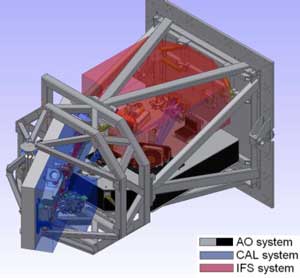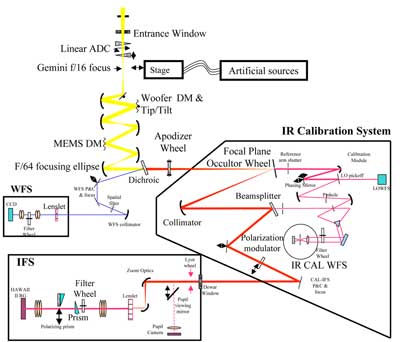 Gemini Planet Imager | Characterizing 200 new exoplanets
Gemini Planet Imager | Characterizing 200 new exoplanets|
ABOVE: GPI's opto-mechanical super structure (OMSS). The diagram maps the locations of the AO, CAL, and coronagraph units. The plate on the right mounts to the Gemini instrument support structure. BELOW: GPI instrument schematic. |
|
GPI Technology Overview |
|
To achieve its contrast goal, GPI consists of six integrated subsystems: 1. The adaptive optics (AO) system, responsible for fast measurement of the instantaneous wave front, and for providing wave front control via deformable mirrors. The optical components and mechanisms for the AO system are provided by the OMSS. The AO system is the responsibility of LLNL. 2. The calibration unit (CAL) is a high-accuracy infrared wave front sensor tightly integrated with the coronagraph. It provides precise and accurate measurements of the time-averaged wave front at the science wavelength and coronagraph focal plane, so that persistent speckles caused by quasi-static wave front errors not dominate the final image. It also provides pointing, focus, and low-order aberration sensing to keep the target star centered on the coronagraph. The CAL system is the responsibility of JPL. 3. The coronagraph uses a combination of apodized masks and focal-plane stops to control diffraction and pinned speckles. The coronagraph masks are the responsibility of the AMNH team; the optical and mechanical components such as pupil wheels or collimating optics will be provided by the other subsystems. 4. The science instrument—an integral field spectrograph (IFS)—produces the final scientific image or data cube, including simultaneous multiple wavelength channels to suppress residual speckle noise and polarimetric capability. It also provides a diagnostic pupil-viewing mode and contains the final Lyot stop for the coronagraph. The IFS is being designed and constructed by UCLA in collaboration with University of Montreal. 5. The upper-level software running on the Top-Level Computer (TLC) coordinates sequencing and communication between subsystems and between GPI and the observatory software. It also provides motion control for all the subsystems. In the previous conceptual design, this was referred to as the Supervisory and Control Computer (SCC). The TLC is being produced by HIA. 6. The opto-mechanical super structure (OMSS) mounts and connects all the subsystems and mates to the Gemini ISS. The AO optics and elements mount directly to the OMSS’ optics bench, while a flexure-sensitive frame holds other major subsystems. This is in turn surrounded by an environmental enclosure with attached electronics racks. The OMSS is also the responsibility of HIA. |

